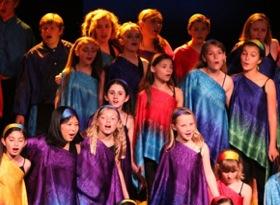Big Kudos to Little Napa
At a time when basic government social services are in jeopardy, it takes mountains of courage and a heap of long-range foresight for a city to make a major commitment to an opera house. Perhaps never have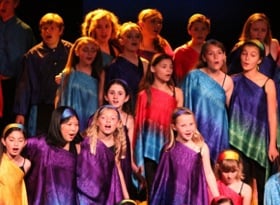
A column item last week contrasted a study showing the enormous economic benefits to Edinburgh from festivals and the decision of the Kansas governor to pull the plug on all state support for the arts. See a report on the approaching disaster in Oakland in this issue of SFCV.
Against the gloom and — probably — doom, consider the Napa city government's action last week, granting $1.5 million to the Napa Valley Opera House, helping "to wipe out its $3.4 million debt by year's end as part of a plan to safeguard its future", says the Napa Valley Register.
By itself, that's an impressive story, but let's put it in context and consider the size of the city: a population of 76,915.
The contribution to the Opera House means $19.50 per resident. If this act of intelligent nobility held true for all the arts in the country, the NEA would have a budget of $6.8 billion. Instead, it continues its downhill fight to save its proposed, and puny, $161.3 million budget. That is a per-capita figure of 52 cents — 1/16th that of Moldova, the poorest country in Europe, and 1/400th of those in better-off countries whose average personal income is still below that in the U.S.
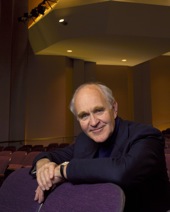
"From the start, we had hoped for support from the City of Napa," Michael Savage told SFCV. "The debt which was incurred during the renovation of the opera house a decade ago has been a burden ever since, and if it can now be removed that will make financially successful programming much easier."
Savage was the Napa Opera House executive director through the renovation, and for the two years after reopening. He also headed the San Francisco Opera House's $88.5 million renovation project after the Loma Prieta quake, and was responsible for the renovation of Yountville's Lincoln Theater.
"Congratulations to the City for their broad vision and to the Opera House board for negotiating such an attractive arrangement," Savage said. "The next task will be to meet the terms of the challenge, but this loan should make the necessary capital fund-raising a little easier too. Bravo!"
Richard Aldag, of the Napa Valley Symphony, which performs in Lincoln Theater [see next item], also greeted the City of Napa's "taking a leadership role in supporting the arts. Their generous grant will ensure that the Napa Valley Opera House will continue to provide a valuable cultural service to the community."
Napa's financial support comes as a challenge grant, a loan that will not have to be repaid if the Opera House follows through on plans for greater economic self-sufficiency.
The money comes from special redevelopment money that must be spent on downtown revitalization. The Register report notes that by obligating the funds, the city further safeguards redevelopment money for local use that Gov. Jerry Brown has been threatening to pull from redevelopment agencies statewide to help solve the state's budget crisis.
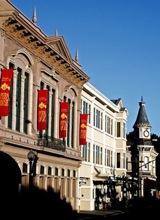
Council members voted unanimously for the forgivable loan, saying that the Opera House was a "community jewel" deserving assistance. "This isn't a giveaway of funds. The city is actually getting something," Councilman Mark van Gorder said. The building will serve as a community facility, but eventually is expected to make a profit.
Since its reopening in 2002, the Opera House has served as a catalyst for new restaurants and had raised the bar for development downtown, city officials said. Opera House customers spend an additional $2.4 million annually in downtown, according to estimates.
Eliminating the building's debt will save the Opera House about $100,000 annually in interest payments. As a nonprofit with a theater of only 455 seats, the Register quotes Opera House Board Chair Bob Almeida as saying, "The Opera House does remarkably well to generate 60 percent of its revenues through ticket sales. Nationally, small nonprofit venues typically generate only 40 percent."
The Opera House hosts 100 to 120 events annually, attracting nearly 30,000 customers, but that's expected to ramp up to as many as 220 events per year, many of them run by community organizations.
Speaking of money and opera, just another reminder that San Francisco Opera's three cycles of Wagner's The Ring of the Nibelung, opening tonight in the War Memorial, cost the company between $23 and $24 million for the entire three-year production (beginning with the 2008 Das Rheingold), but San Francisco will benefit economically many times over that amount.
Says Kary Schulman, director of the city's Grants for the Arts:
For San Francisco, having the full Ring cycle here is like hosting a Super Bowl or World Cup soccer for the arts. We gain not just additional hotel stays, restaurant meals and shopping but, because these are culture-goers, our other arts and visitor attractions are likely to benefit as well.
Napa Valley Symphony Season
The Napa Valley Symphony, resident in the Lincoln Theater, is making do without a music director again, by inviting another all-guest lineup to rotate duties on the podium and by presenting the work of local composers. Executive Director Richard Aldag calls the 2011-2012 season "one of the most interesting the Symphony has ever presented."
The variety, both of programs and conductors, is unquestionable. In addition to the standard fare, NVS is introducing a new project, called "Made in Napa," of new works written by local composers: Aldag's own Les Bijoux for Violin and Orchestra, Jason Nett's Sol, and Robert Wright's Twilight at Mt. Veeder. The composers will speak about their works an hour before the concerts.
- Leading the Sept. 25 season-opener is Josep Caballé-Domenech, in works by Juan Crisóstomo de Arriaga, Poulenc, Mozart, and Brahms; Christina and Michelle Naughton, pianists.
- Alondra de la Parra conducts the Nov. 6 concert, of music by Villa-Lobos, Elgar, Brahms, and Wright; with the Cyprus String Quartet.
- On Dec. 11, Dmitry Sitkovetsky conducts works by Bach and Vivaldi, plus a Christmas carol sing-along.
- The 2012 season begins with Jayce Ogren conducting the music of Debussy, Tchaikovsky, and Aldag; violinist Jennifer Frautschi is soloist.
- Wagner and Beethoven are on the schedule on March 11, with Philippe Entremont as conductor and pianist.
- The May 20 season-closer is conducted by Constantine Kitsopoulos, featuring the music of Milhaud, Haydn, and Nett.
Crocetto in Wales
At this week's Cardiff Singer of the World competition, second-year Adler Fellow and 2008 Merola alumna soprano Leah Crocetto represents the U.S. She is among 20 competitors selected from more than 600 singers from 68 countries.
There is a complex schedule of BBC broadcasts, but as of now, I can't tell when (or if) webcasts will be available here — more information to come later in the comments section, at the end of this column. Crocetto's turn is (or rather was) today, at 6 a.m.
Since the first contest, in 1983, won by Karita Mattila, these are the "Singers of the World," counting backward: Ekaterina Scherbachenko, 2009; Shen Yang, 2007; Nicole Cabell, 2005; Tommi Hakala, 2003; Marius Brenciu, 2001; Anja Harteros, 1999; Guang Yang, 1997; Katarina Karnéus, 1995; Inger Dam-Jensen, 1993; Lisa Gasteen, 1991; Dmitri Hvorostovsky, 1989; Valeria Esposito, 1987; and David Malis, 1985.
Organ Donors
As part of the upcoming American Guild of Organists' Region IX convention to be held in the Bay Area, many free concerts will be open to the public. The San Francisco chapter is celebrating its centennial; Region IX includes Arizona, California, western Colorado, Hawaii, Nevada, Utah, as well as Korea, Singapore, Sydney, and Taiwan. More than 300 organists are expected here in the first week of July.Some of the free events:
- July 2, 9 a.m. to 5 p.m., at St. Luke's Episcopal Church, regional competition for young organists
- July 3, 7:15 p.m., Temple Emanu-El, convention opening service
- July 5, 10:30 a.m., St. Luke’s Episcopal Church, recital by winner of young organists' competition
- July 6, 3 p.m., Cathedral of St. Mary of the Assumption, chant vespers with organist Samuel Soria
- July 6, 8 p.m., Grace Cathedral, recital by organist Amy Johansen
Other Rings
Yes, Virginia, there is more to The Ring of the Nibelung than the San Francisco Opera production, the first cycle of which begins today. To wit:The Merry Nibelungs
"A Wagnerian operetta meets Mel Brooks with a touch of South Park, don't bring the kids," says the announcement of the production featuring Ross Halper as Siegfried. It plays in the Shelton Theater on Union Square, June 16, 23, and 30. Says Halper:
This is a verbally fractured but musically faithful version of Oscar Straus' 1904 Die Lustigen Nibelungen. A satire not a spoof, we (including Oscar) aim our darts at Wagnerians more than Wagner. With a guest appearance by Cosima Wagner, it is a bawdy festspiel, with special treats for Wagnerites.
Seattle '13
The Stephen Wadsworth–Thomas Lynch Ring returns to Seattle in 2013 for the fourth time, to be conducted by Asher Fisch. Making their Seattle debuts in this production will be Alwyn Mellor as Brünnhilde and Stefan Vinke as Siegfried. Greer Grimsley appears as Wotan, Stephanie Blythe as Fricka, Margaret Jane Wray as Sieglinde, Stuart Skelton as Siegmund, Dennis Petersen as Mime, and Richard Paul Fink as Alberich.
French Ring on BBC-3
You have until Thursday to hear repeat broadcasts of the new Opéra de Paris Das Rheingold on BBC-3. The other three operas are broadcast as follows: Die Walküre, June 15-17; Siegfried, July 6-8; Götterdämmerung, July 14-15.
Conducted by Philippe Jordan, Das Rheingold features Falk Struckmann as Wotan, Peter Sidhom as Alberich, and Kim Begley as Loge. "German director Günter Krämer's staging ... has been a tour de force of violent passions, gripping symbolism and whimsical diversion," reports Musical America. "Brought to its bloody conclusion with Götterdämmerung, this Ring represents the company's first presentation of the full tetralogy since 1957."
As did Francesca Zambello's production in San Francisco, Krämer places the story in a contemporary setting. His Rheingold has envisioned a progression from the early-middle decades of the 20th century. Die Walküre features World War II references; Siegfried is set in 1950s, complete with Mime dressed as a beatnik who grows and smokes his own marijuana. ("Our Mime" has a house trailer, with Rheingold beer, no marijuana.)
Götterdämmerung takes place in 1970s, with Gunther sporting an olive-green leisure suit and aviator sunglasses. Siegfried and Hagen wear drab, three-piece suits that make them look like Ford administration cabinet members.
The Lord of the Rings in Concert
Here comes a Fellowship of the Ring concert in Oakland's Oracle Arena on Oct. 22 at 2 and 8 p.m. The ad says: "Watch on an immense 60-foot screen, accompanied by the complete Academy Award–winning score, performed live by more than 250 musicians, including the Munich Symphony Orchestra, Pacific Chorale, and Phoenix Boys Choir."
Report from Spoleto USA
The New York Times review from Charleston praises San Francisco's Sarah Cahill for her program "reflecting on peace and war," saying that her performances were "superb." At the same time, the remark that "much of the music seemed worthy of greater attention than a listener was allowed to give it" was meant as a slap at John Sanborn's video.
Cahill performed music by Preben Antonsen, Jerome Kitzke, Paul Dresher, Terry Riley, and Meredith Monk, with Sanborn supplying a "video interpretation" to accompany each piece.
"Or that seemed to be the idea," says James Oestrich's review. "But Mr. Sanborn’s videos were generally so insistent on themselves, and often so garish, that they reduced the music to mere accompaniment. They mostly used abstract figures or concrete images (faces and flowers) deconstructed or magnified into abstractions. Some made obvious points (images in twos and threes for Mr. Dresher’s "Two Entwined," with its meshing of double and triple meters); others were merely — but loudly — decorative."
See the same review for a detailed report on the American premiere of Kaija Saariaho's monodrama Émilie, with Elizabeth Futral.
'Adventurous Programming' Awards
No fewer than 26 American orchestras were recognized with 2010–2011 ASCAP Awards for Adventurous Programming last week at the League of American Orchestras' 66th Annual Conference in Minneapolis. More than a million dollars has been bestowed on orchestras since the awards were established in 1947.Cabrillo Festival of Contemporary Music received its 28th consecutive first-place award in the festival category. First places in various categories went to the Los Angeles Philharmonic, New York Philharmonic, and Michael Tilson Thomas' New World Symphony (in Miami). Berkeley Symphony received a second place.
During the San Francisco Symphony's upcoming centennial season, six major American orchestras will appear in Davies Symphony Hall: Los Angeles Philharmonic (with Gustavo Dudamel), Oct. 23-24; Boston Symphony (Ludovic Morlot), Dec. 6-7; Chicago Symphony (Riccardo Muti), Feb. 14-15; Cleveland Orchestra (Franz Welser-Möst), April 15-16; New York Philharmonic (Alan Gilbert), May 13-14; and Philadelphia Orchestra (Charles Dutoit), June 9-10.
Inma Shara
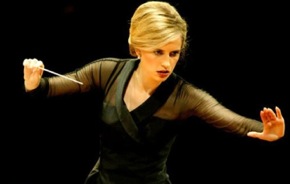
She is Spain's Inma Shara, 38, who has led a score of big European orchestras and appeared in Asia, but has yet to make her U.S. debut.
Shara has conducted a concert in Vatican City, attended by the Pope, celebrating the 60th anniversary of the Universal Declaration of Human Rights. She has been awarded prizes for her humanitarian work, as well as for conducting, and was invited by the European Commission to conduct the European Union Youth Orchestra on the closing day of the World Expo in Shanghai last year.
Of several Sony recording projects in the works, one was released recently, La Isla de los Sonidos.
Besides Shara, who else is missing from a list of Marin Alsop, Susanna Mälkki, Joanne Faletta, Jane Glover, Rachel Worby, and Simone Young?

